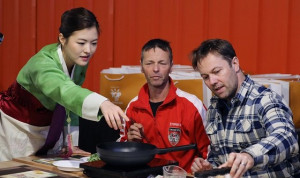In the first half of this year, Korea food companies performed remarkably despite the economic downturn caused by a coronavirus. This is because many people tend to cook at home or stock up on food that can be stored for a long time instead of doing outdoor activities. Ramen, for example, has drawn attention as an emergency food due to the Corona incident. People also began to recognize ramen as a substitute for meals, not as a snack. The purchase rate of ramen has risen significantly every year. In the past three years, Korea has made the first in the noodle category of U.S. imports. Like this, K-food sold like hotcakes. The love for K-food continues around the world.
Some of you might think that K-food just refers to Korean traditional food. Not long ago, foreigners usually thought of Korean traditional foods such as kimchi and bulgogi when they talked about K-food. Not only Korea traditional foods but also other various foods such as ramen, tteokbokki, mandu, and bingsu are loved by many people these days. Now, all food made in Korea has become part of the K-food category. This change is caused by the development of SNS. Mukbang, which means an eating show, became famous in one-man broadcasting. As the clip of K-food mukbang spread to SNS raising high views, people got interested in K-food. People also enjoyed uploading lots of images of themselves eating K-food on SNS. It became a new food trend. Besides, there are challenges with K-food that are drawing attention. One famous example is the Fire noodle challenge. Many YouTubers from home and abroad participated in this challenge and uploaded their videos. Many people also started to challenge themselves and shared with others. They enjoyed the challenge. It became one of the most famous games. As a result, Buldak stir-fried noodles which is the fire noodle became an icon of challenge and led to K-food fever. These kinds of activities allowed people to enjoy K-food more easily that may not have been familiar with foreigners. The development of SNS lowers the barrier to entry to K-food.

These kinds of activities have not only been a one-off but have become part of trends and cultures. Some people kept finding K-food to enjoy the taste and began to love K-food. Also, an interest in K-pop and K-drama led to an interest in K-food. People found K-food in Korean cultural contents attractive. More people started to enjoy the new food trend. The K-food fever will continue on and on.
Nahyun Lee
Asia Journal
Los Angeles Times Advertising Supplement




